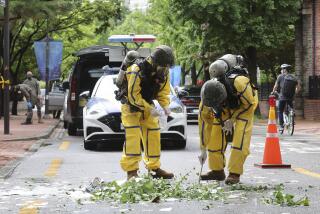Industry Says ‘Killer Balloon’ Theory Is Simply Hot Air : Safety: Children’s belief that animals have been harmed by eating stray helium balloons has cost millions in lost sales.
- Share via
WASHINGTON — A familiar but exhilarating sight: Thousands of brightly colored helium balloons soar into the air, get caught by the wind, disappear into tiny points against the sky.
And kill thousands of helpless animals.
That, anyway, is what many of the nation’s children believe, and it’s giving the balloon industry a severe gas attack.
Jackie Simms, 11, says her fifth-grade classmates in Kent, Ohio, “can’t understand why people launch balloons just for enjoyment.”
“They know that it does kill the animals and it does litter the ground, too,” she said.
America’s balloon sellers say they are in a battle for kids’ hearts and minds--and they’re losing.
“The children don’t want anyone to buy balloons any more,” said Philip Levin, president of Balloon City USA, a national wholesaler in Harrisburg, Pa.
“The schoolchildren are the ones that go to the state legislators and say we should ban balloons,” Levin said. “Crying children say we’re killing millions of animals.”
The balloon industry disputes any suggestion that animals--on land or at sea--have been harmed by eating stray helium balloons.
“This office has yet to have evidence that a balloon has been the primary cause of death in any case,” said Mark Brown, director of communications for the National Assn. of Balloon Artists in Jacksonville, Fla.
“These misinformation reports are turning into an attack on our industry,” Brown said. “Children say, ‘Oh no, I can’t take that balloon. It might kill a whale.’ ”
Florida, Connecticut and Tennessee have enacted laws banning or restricting balloon launches. Under pressure from schoolchildren, several cities have passed similar ordinances.
The association says the ruckus is costing balloon sellers $6 million a year. Many customers have canceled orders for earthbound balloons as well, even though the controversy directly relates only to the release of lighter-than-air models.
The dispute traces back to 1985, when a dead whale washed up in New Jersey. Robert Schoelkopf of the Marine Mammal Stranding Center in Brigantine, N.J., found a Mylar plastic balloon in the whale’s stomach. That kind of balloon is not used in launches, which are done exclusively with balloons made of latex, a kind of rubber.
“Although there are no documentations of animals dying directly from ingestion of balloons, we think it has been a contributing factor,” Schoelkopf said.
In 1987, science teachers Susan and Peter Hibbard in Toms River, N.J., founded the Balloon Alert Project after finding a white latex balloon inside a dead leatherback sea turtle.
“We never said it caused the death of the turtle, but it was in the turtle where it did not belong,” Susan Hibbard said.
Asked about the industry assertion that there has been no proof that any animal was ever killed by a balloon, she said: “They can’t prove that the balloons haven’t killed any animals. As far as the litter problem, we can prove it.”
Linda Maraniss, regional director of the Center for Marine Conservation in Austin, Tex., says annual beach cleanup drives have collected tens of thousands of balloons nationwide.
“In Florida, we found a balloon from a Ford dealership in Georgia,” she said.
The balloon industry says most helium balloons climb about five miles high, where they burst into tiny pieces of latex. Brown said latex is a natural, biodegradable material that decays at about the same rate as oak leaves.
“Then you have to ask yourself how long it takes an oak leaf to degrade,” Maraniss replied.
At Bromfield School in Kent, Jackie Simms and the other students in the fifth-grade class taught by Patricia Moore are doing experiments to see how fast balloons degrade.
“We have oak leaves and balloons on trays outside,” Moore said. “We’ve made a chart of research for and against balloon launches.”
More to Read
Inside the business of entertainment
The Wide Shot brings you news, analysis and insights on everything from streaming wars to production — and what it all means for the future.
You may occasionally receive promotional content from the Los Angeles Times.










